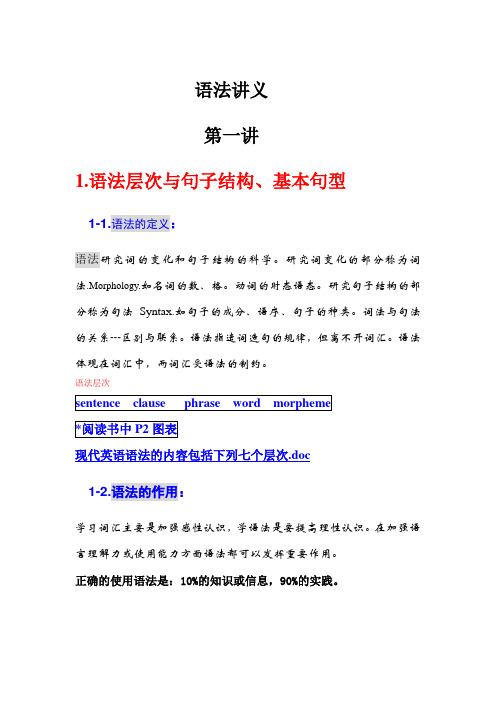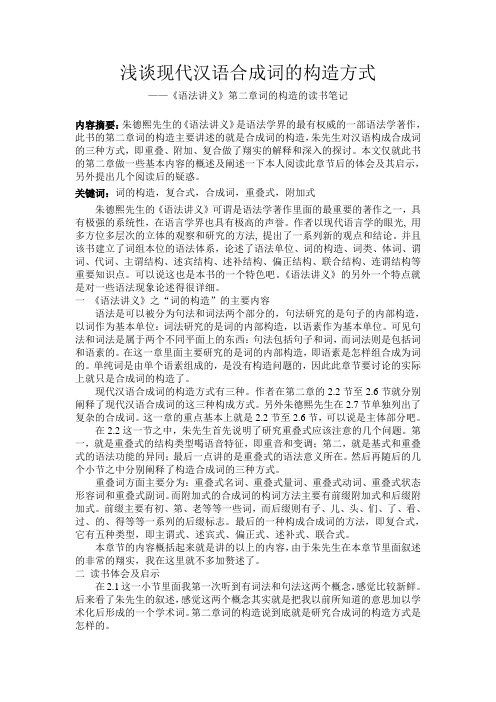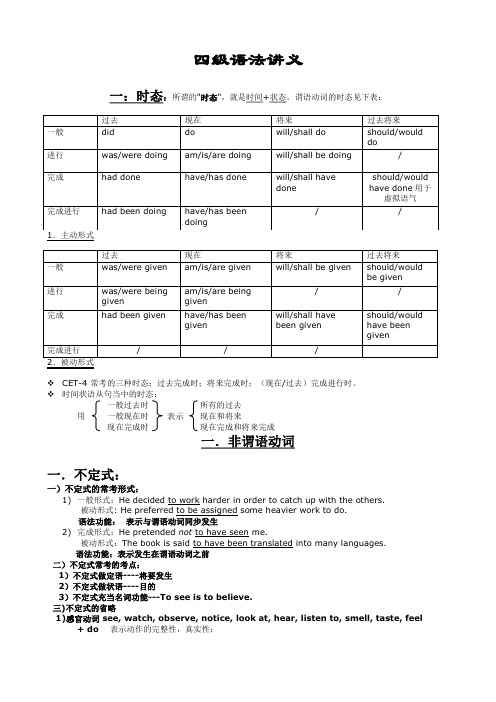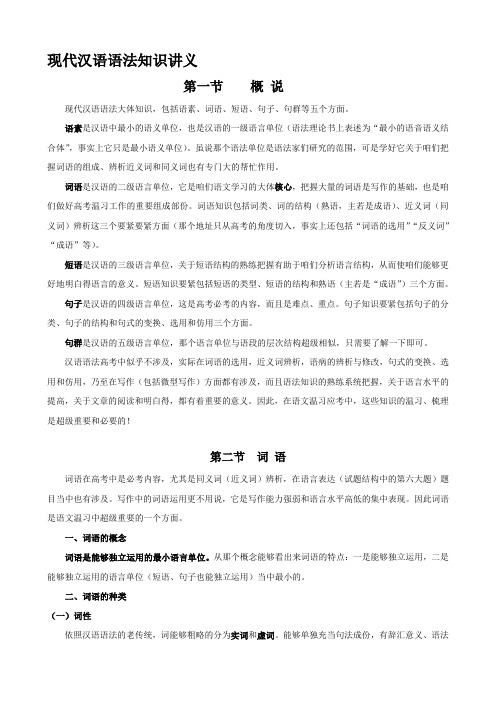功能语法讲义
语法讲义第一讲导论

语法讲义第一讲1.语法层次与句子结构、基本句型1-1.语法的定义:语法研究词的变化和句子结构的科学。
研究词变化的部分称为词法.Morphology.如名词的数、格。
动词的时态语态。
研究句子结构的部分称为句法Syntax.如句子的成分、语序、句子的种类。
词法与句法的关系---区别与联系。
语法指遣词造句的规律,但离不开词汇。
语法体现在词汇中,而词汇受语法的制约。
语法层次现代英语语法的内容包括下列七个层次.doc1-2.语法的作用:学习词汇主要是加强感性认识,学语法是要提高理性认识。
在加强语言理解力或使用能力方面语法都可以发挥重要作用。
正确的使用语法是:10%的知识或信息,90%的实践。
第一.词法2-词的分类:要弄清句子成分应由哪类词担任,分清词类非常重要。
如:主语,宾语多有名词担任;谓语多有动词担任;定语常有形容词担任;状语多有副词担任;词分为10大类:2-1.名词:表示人、物或地方等,如:John,teacher;table,pen;London;beauty.2-2.代词:用来代替名词,以避免重复某个名词,如:I,you,it,that,those,them.2-3.形容词:用来修饰或限制某个(些)名词,如:good(man),white(paper),every(book),much(water),被修饰或限制的名词,叫做主体词(head-word)。
2-4.动词:表示行为或状态,如:speak,read,go,think,is,seem.2-5.介词:表示它后面的名词(或代词)跟它前面的动词、另一名词或形容词的关系。
这些名词(或代词)称为介词的宾语。
介词宾语和介词构成介词短语。
The book on the desk is mine.(介词on把名词book和另一名词desk联系起来)He is sure of it.他对此很有把握。
(of联系it和sure.)It is good for you.这对你有好处。
语法讲义

特殊疑问句强调句型的构成:
特殊疑问词+be+it+that+句子的其他部分(用
陈述语序)例如: When did you receive the gift? 对特殊疑问词when做强调: When was it that you received the gift? 到底啥时你收到的礼物?
It was in a marketplace that John bought an old bike yesterday. 约翰是在市场上昨天买了辆旧自行车。(强 调地点状语) 练习: 1、Peter lent us the money. 2、Mary met an old beggar in the street yesterday.
John bought an old bike yesterday
主语 宾语 时间状语 In the marketplace. 地点状语 It was John that//who bought an old bike yesterday in the marketplace 是约翰昨天在市场上买了辆旧自行车。(强 调主语)
3.强调句型的判断
可以将两句型中的It is(was)及that全部省去,若 剩余的部分可以组成一个完整的句子,便是强调句 型,否则为名词性从句。如: It was his best suit that Xiao shen yang wore to dance last night. 将his best suit置入that之后的句中,可以组成 Xiao shen yang wore his best suit to dance last night表示“小沈阳昨晚穿着他最好的衣服去跳舞。”
《语法讲义》(朱德熙著)第二章词的构造的读书笔记

浅谈现代汉语合成词的构造方式——《语法讲义》第二章词的构造的读书笔记内容摘要:朱德熙先生的《语法讲义》是语法学界的最有权威的一部语法学著作,此书的第二章词的构造主要讲述的就是合成词的构造,朱先生对汉语构成合成词的三种方式,即重叠、附加、复合做了翔实的解释和深入的探讨。
本文仅就此书的第二章做一些基本内容的概述及阐述一下本人阅读此章节后的体会及其启示,另外提出几个阅读后的疑惑。
关键词:词的构造,复合式,合成词,重叠式,附加式朱德熙先生的《语法讲义》可谓是语法学著作里面的最重要的著作之一,具有极强的系统性,在语言学界也具有极高的声誉。
作者以现代语言学的眼光, 用多方位多层次的立体的观察和研究的方法, 提出了一系列新的观点和结论。
并且该书建立了词组本位的语法体系,论述了语法单位、词的构造、词类、体词、谓词、代词、主谓结构、述宾结构、述补结构、偏正结构、联合结构、连谓结构等重要知识点。
可以说这也是本书的一个特色吧。
《语法讲义》的另外一个特点就是对一些语法现象论述得很详细。
一《语法讲义》之“词的构造”的主要内容语法是可以被分为句法和词法两个部分的,句法研究的是句子的内部构造,以词作为基本单位:词法研究的是词的内部构造,以语素作为基本单位。
可见句法和词法是属于两个不同平面上的东西:句法包括句子和词,而词法则是包括词和语素的。
在这一章里面主要研究的是词的内部构造,即语素是怎样组合成为词的。
单纯词是由单个语素组成的,是没有构造问题的,因此此章节要讨论的实际上就只是合成词的构造了。
现代汉语合成词的构造方式有三种。
作者在第二章的2.2节至2.6节就分别阐释了现代汉语合成词的这三种构成方式。
另外朱德熙先生在2.7节单独列出了复杂的合成词。
这一章的重点基本上就是2.2节至2.6节,可以说是主体部分吧。
在2.2这一节之中,朱先生首先说明了研究重叠式应该注意的几个问题。
第一,就是重叠式的结构类型喝语音特征,即重音和变调;第二,就是基式和重叠式的语法功能的异同;最后一点讲的是重叠式的语法意义所在。
《对外汉语教学语法体系》讲义

《对外汉语教学语法体系》讲义
语法概说
什么是语法
语法分析和语法单位
语法形式和语法意义
语法体系
汉语语法的特点
1、汉语缺乏严格意义的形态变化
2、汉语注重意合
3、汉语的词类和句法成分不一一对应
识别词类的方法
根据划分词类的标准:语法功能
组合功能
句法功能
类别功能
识别的窍门:记小类
名词
代词
动词
形容词
数词
量词
介词
副词
连词
助词
叹词
象声词
词类的教学分布
构成语法点出现在教材中
构成表达式出现
分布在句子当中
词的兼类
“零”和“半”
“二”和“两”
三、小数、分数的读法
四、倍数的读法
五、序数的读法
“第”的用法
号码读法
六、概数表示法
相邻数字的并列
“几”和“多”
表概数的词语
量词的语义特征
一、量词和名词在语义上的联系
4、离合词的重叠方式是AAB
5、离合词可以受程度副词的修饰
6、有的离合词可以倒序
三、离合词的教学方法
词的组合
一、短语概述
二、短语的类别
1、短语的结构类别
2、短语的功能类别
句子和句子成分
主—谓中的主语和谓语
三、指示代词的活用
能愿动词
一、能愿动词的语法特征
二、能愿动词的词义分析
1、能愿动词的一词多义
“能”:
“会”:
“可以”:
“要”
大学英语四级(cet4)语法讲义

四级语法讲义一:时态:所谓的"时态",就是时间+状态。
谓语动词的时态见下表:1.主动形式2.被动形式CET-4 常考的三种时态:过去完成时;将来完成时;(现在/过去)完成进行时。
时间状语从句当中的时态:一般过去时所有的过去用一般现在时表示现在和将来现在完成时现在完成和将来完成一.非谓语动词一.不定式:一)不定式的常考形式:1)一般形式:He decided to work harder in order to catch up with the others.被动形式: He preferred to be assigned some heavier work to do.语法功能:表示与谓语动词同步发生2)完成形式:He pretended not to have seen me.被动形式:The book is said to have been translated into many languages.语法功能:表示发生在谓语动词之前二)不定式常考的考点:1)不定式做定语----将要发生2)不定式做状语----目的3)不定式充当名词功能---To see is to believe.三)不定式的省略1)感官动词 see, watch, observe, notice, look at, hear, listen to, smell, taste, feel+ do表示动作的完整性,真实性;+ doing表示动作的连续性,进行性I saw him work in the garden yesterday.昨天我看见他在花园里干活了。
(强调"我看见了"这个事实)I saw him working in the garden yesterday.昨天我见他正在花园里干活。
(强调"我见他正干活"这个动作)感官动词后面接形容词而不是副词:The cake tastes good; It feels comfortable.2) 使役动词 have bid make let 等词后不定式要省略但同1)一样被动以后要还原toI ‘d like to have John do it.I have my package weighed.Paul doesn’t have to be mad e to learn.3) help help sb do help sb to do help do help to do四)有些动词后只跟不定式如:want,wish,hope,manage,promise,refuse,pretend,plan, offer,decide,agree,expect allow sb to do, cause sb to do , permit sb to do, enable sb to doforce sb to do. be more likely to do love to do warn sb to do be able to dobe ambitious to do. begin to do . start to do五) 有的时候to后面要接-ing形式accustom (oneself) to; be accustomed to; face up to; in addition to; look forward to; object to; be reduced to; resign oneself to; be resigned to; resort to; sink to; be used to; be alternative to; be close/closeness to; be dedication/dedicated to; be opposition/opposed to; besimilarity/similar to.三、need/want 后的-ing形式具有被动的意思。
现代汉语语法基础讲义

现代汉语语法知识讲义第一节概说现代汉语语法大体知识,包括语素、词语、短语、句子、句群等五个方面。
语素是汉语中最小的语义单位,也是汉语的一级语言单位(语法理论书上表述为“最小的语音语义结合体”,事实上它只是最小语义单位)。
虽说那个语法单位是语法家们研究的范围,可是学好它关于咱们把握词语的组成、辨析近义词和同义词也有专门大的帮忙作用。
词语是汉语的二级语言单位,它是咱们语文学习的大体核心,把握大量的词语是写作的基础,也是咱们做好高考温习工作的重要组成部份。
词语知识包括词类、词的结构(熟语,主若是成语)、近义词(同义词)辨析这三个要紧要紧方面(那个地址只从高考的角度切入,事实上还包括“词语的选用”“反义词”“成语”等)。
短语是汉语的三级语言单位,关于短语结构的熟练把握有助于咱们分析语言结构,从而使咱们能够更好地明白得语言的意义。
短语知识要紧包括短语的类型、短语的结构和熟语(主若是“成语”)三个方面。
句子是汉语的四级语言单位,这是高考必考的内容,而且是难点、重点。
句子知识要紧包括句子的分类、句子的结构和句式的变换、选用和仿用三个方面。
句群是汉语的五级语言单位,那个语言单位与语段的层次结构超级相似,只需要了解一下即可。
汉语语法高考中似乎不涉及,实际在词语的选用,近义词辨析,语病的辨析与修改,句式的变换、选用和仿用,乃至在写作(包括微型写作)方面都有涉及,而且语法知识的熟练系统把握,关于语言水平的提高,关于文章的阅读和明白得,都有着重要的意义。
因此,在语文温习应考中,这些知识的温习、梳理是超级重要和必要的!第二节词语词语在高考中是必考内容,尤其是同义词(近义词)辨析,在语言表达(试题结构中的第六大题)题目当中也有涉及。
写作中的词语运用更不用说,它是写作能力强弱和语言水平高低的集中表现。
因此词语是语文温习中超级重要的一个方面。
一、词语的概念词语是能够独立运用的最小语言单位。
从那个概念能够看出来词语的特点:一是能够独立运用,二是能够独立运用的语言单位(短语、句子也能独立运用)当中最小的。
高中英语语法专题----多功能的动词 讲义(无答案)
高中英语教师辅导教案课次编号:年级:课时数:学员姓名:辅导科目:英语学科教师:授课时间:动词做谓语与非谓语的判断技巧学习目标动词常考的时态标志词与固定搭配教学内容【知识导图】【语法项目罗列】一、作谓语还是非谓语的判定二、谓语动词1.时态标志词2.主谓一致3.并列词或结构和固定句型的时态4.并列关系在分析句子成分中扮演重要的角色5.无被动形式与进行时形式的动词 (consist of \ belong to \...)判断填谓语动词还是非谓语动词的技巧1.若句中找不到谓语,则所给动词应该作谓语一个句子无论是主句还是从句,必须要有谓语。
一般来讲,空格所在的句子中无其他动词,那么这个空就应填谓语动词。
谓语动词需考虑动词的时态、语态、主谓一致等。
China’s high-speed railways (grow) from 9,000 to 25,000 kilometers in the past few years.The giant panda (love) by people throughout the world.2.若句中已有谓语动词,且另一动作(空格处)不作并列谓语时,则所给动词一定用作非谓语动词。
非谓语动词需确定是v.-ing形式、v.-ed形式还是不定式。
During the Mid-Autumn Festival, family members often gather together (share) a meal, admire the moon and enjoy moon cakes.Inside,though,the place was practically empty—there was just one couple,________(sit)at a table near the window.3.长难句分析(2015·全国卷Ⅰ)A study of travelers (conduct) by the website TripAdvisor names Yangshuo as oneof the top 10 destinations in the world.(2018陕西质检)In 1638, John Harvard, pastor of Charlestown, passed away. He left his library and half his estate to the institution, __6________ were the biggest donation ever since its establishment. Therefore, the university was named after his name. Today, you can find a statue of John Harvard __7________ (stand) in front of the University Hall in Harvard Yard, and it is perhaps the University's best __8__________ (know) landmark.易混示例,理清谓语动词和非谓语动词[题组一]①He volunteered to help control traffic, (donate) an hour of his time every week.②He volunteered to help control traffic, and (donate) an hour of his time every week.[题组二]① (call) me tomorrow and I’ll let you know the lab result.② (call) me tomorrow, I’ll let you know the lab result.[题组三]①The guide (lead) the way, we had no trouble getting out of the forest.②The guide (lead) the way, so we had no trouble getting out of the forest.[题组四]①The party will be held in the garden, weather (permit).②The party will be held in the garden, if weather (permit).[题组五]①Jim was listening attentively to the lecture, and all his attention (fix) on it.②Jim was listening attentively to the lecture, (with) all his attention (fix) on it.③Jim was listening attentively to the lecture, (fix) all his attention on it.[题组六]①He went into the room, (sit) at the table and began to read newspapers.②They walked along the stream together, (talk) and laughing.动词作谓语解题技巧知识梳理1.看时间状语定时态(1)一般现在时:always, often, seldom, sometimes, usually,at the moment等;(2)一般过去时:yesterday, last night, a few days ago, the other day, one rainy day等;(3)一般将来时态:tomorrow, next year, in a week等;(4)现在进行时:all the time, at present, now, at this moment等;(5)现在完成时:already, just, yet, so far, for+一段时间;since+过去的时间点或ever since; in/over/during/for the last/past+一段时间等。
现代汉语讲义(第四章语法)
(五)语助词 助词表示某种特定的附加语法意义, 语气词主要表示句子的语气。
1.助词:黏着在词或短语上面,表示附 加意义,附着在后面的一律读轻声。 助词的分类:结构助词、时态助词、 其他助词。
2.语气词:一般用于句末表示语气,永 远黏着、后附、轻声。也可用于句中,主 要用在主语后。 语气词的分类:表陈述、疑问、祈使、 感叹语气四类。
二、单句
1.主谓句 (1)动词性谓语句 可分为动词谓语句、述宾谓语句、述 补谓语句、连谓谓语句、兼语谓语句、 主谓谓语句。 (2)形容词性谓语句 形容词谓语句、形补谓语句。 (3)名词性谓语句 名词谓语句、数量谓语句、定心谓语 句。
2.非主谓句。 (1)名词性非主谓句 (2)动词性非主谓句 (3)形容词性非主谓句 (4)特殊非主谓句
3.偏正词组:前面的成份(修饰语)修饰 限定后面的成份(中心语)。可分为体词性 的和谓词性的两类。 修饰语是定语的称为定心词组,是名词性 词组。 修饰语是状语的称为状心词组,是谓词性 词组。
4.述补词组:补充与被补充的关系。 根据带不带结构助词“得”可分为:(1) 数量补语:量词结构作补语,不能带“得” ;(2)情态补语:补语说明动作或有关事务 的状态,必须带“得”;(3)结果补语:补 语表示动作的结果,可由形容词或动词充当 ,不带“得”;(4)趋向补语:补语表示动 作的趋向,不带“得”;(5)可能补语:补 语表示可能性或不可能性,由结果补语和趋 向补语中间插入“得/不”;(6)程度补语 :补语表示程度,由副词构成。
三、存现句 存现句的类别。
四、把字句 把字句的特点。
五、被字句 被字句的特点及变体。
第八节 句类系统
句类是按照句子的语气功能划分出 来的类型系统。
一、陈述句 语气词及否定形式。
高中英语 高中简明语法系列---形容词副词分类与功能讲义
形容词形容词(Adjective)用来修饰名词或代词,描绘人和事物的特征。
形容词在句中一般用作定语、主语补语或宾语补语。
补语性形容词和定语性形容词根据形容词的句法功能,形容词可以分为补语性形容词和定语性形容词。
多数形容词既可以作名词的修饰语又可以作主语的补语。
1.只能作补语的形容词(1)以a-开头的形容词,如alone 单独,asleep 熟睡的,awake醒着的,alive活着的,alike 同样的,afraid 害怕,ashamed羞愧看下例:He is fast asleep in his bedroom.他在卧室熟睡。
We are fully aware of the difficulty.我们充分认识到困难。
I felt ashamed of my terrible mistake.我为自己的严重错误感到羞愧。
Paul was again absent from the meeting.鲍尔开会再次缺席。
(2)表示健康状况的形容词well 健康,ill 患病,faint 虚弱。
例如:I didn't feel well, but the doctor said it was nothing serious.我感觉不舒服,可医生说没什么要紧。
His strength grew faint as he was getting on in years.他上了年纪,体力虚弱。
(3)某些表示情感和心理状态的形容词。
例如:I'm glad of your great success in your study.我为你学习上的巨大成功感到高兴。
Shella was sorry about what she had done.希拉对自己的行为感到后悔。
My grandfather is fond of cycling.我祖父喜欢骑自行车。
He is content with his present job and position.他满足于自己的工作和地位。
语言类型学讲义(共147张PPT)
1.3.4 认知语言学
• 功能理念与形式学派式测试研究方法的结合
1.4 同类课题三种方法如何研究
——以双及物结构为例
测试法:以句式测试为例
还可以进行有定无定测试
•
我给他书。/
我送他书。/
我还他书。/
(给这位先生一杯红茶。 我卖他书。/~*我?给买他一书位。先/ *生我倒这他杯茶红。 茶)、
有怎样的优先系列(给予义、获得义、告诉义、显示义……),双及
物结构在被动化、话题化和关系化等语法过程的关系……
1.5 各派方法的局限
形式学派注意定性(合格与不合格之别)而忽略定量,可语法中 并不处处存在合格不合格的纯粹定性标准。从单一语言中总结出 的规律实际上混杂了人类语言普遍规则和个别语言特有规则两种 情况。
-P, +Q -P, -Q
2.2.1 蕴涵性共性与四分表
• (2) WX YZ
GU25:假如代词性宾语后置于动词,那么名词性宾语也 同样如此(GU代表Greenberg1966所建立的共性)
VOp Von
由 WX YZ 可推出: ZY XW (如OnV OpV)
但不能推出:
YZ WX (如不能推出 VOn VOp)
成的基础犹如文化人类形成的基础:复数意义的文化观念和语言 观念。“夷夏之辨”,自我中心不利其产生。
• 古典类型学:形态分类法(屈折语,粘着语、孤立语及后 加入的多
式综合语);对语言要素之间跨语言的相关性的注意是蕴涵性语言共 性的萌芽。
结构主义对语言个性的强调:你今天认为是人类语言共同特性的
东西,也许在你明天调查的一种语言中就被打破。
- 1、下载文档前请自行甄别文档内容的完整性,平台不提供额外的编辑、内容补充、找答案等附加服务。
- 2、"仅部分预览"的文档,不可在线预览部分如存在完整性等问题,可反馈申请退款(可完整预览的文档不适用该条件!)。
- 3、如文档侵犯您的权益,请联系客服反馈,我们会尽快为您处理(人工客服工作时间:9:00-18:30)。
Halliday and Systemic-Functional GrammarM. A. K. Halliday (1925–), based on Firth‘s theories in the London School, has developed his Systemic-Functional Grammar (SFG).1. Biography of Halliday:1947From 1947 to 1949From 1949 to 195019551955 onwards197519882. Brief introduction of SFG:Systemic-Functional Grammar has two inseparable components: systemic grammar and functional grammar.1) Systemic grammar:It aims to explain the internal relations in language as a system network.Language is a system network.This system network is thought as meaning potential.This system network consists of subsystems.Language users make choices from these subsystems.2) Functional grammar:It aims to reveal that language is a means of social interaction.People use language to interact with each other.Meanwhile they make choices from the subsystems of language according to different functions they serve.Therefore, the function or use of language determines language system.3) Systemic-Functional Grammar is based on two facts:(1) Language users are actually making choices in a system of systems and trying to realize different semantic functions in social interaction(2) Language is inseparable from social activities of man.¤Language is a potential: it is what the speaker can do. (Halliday 1978/2001: 27) …hence the description of language as a ‗meaning potential‘. (Halliday 1978/2001:28)¤The notion of ‗situation‘ refers to those features which are relevant to the speech that is taking place.(Halliday 1978/2001: 29)3. Systemic GrammarIn Systemic Grammar, language is conceived as a ―system of systems‖. Systemic Grammar tries to establish a network of systems of language. Language is regarded as a multilevel code system, as is shown below:This is what Halliday called the three strata of language.¤Language is being regarded as the encoding of a ‗behaviour potential‘; that is, as a means of expressing what the human organism ‗can do‘, in interaction with other human organisms, by turning it into what he ‗can mean‘. What he can mean (the semantic system) is, in turn, encoded into what he ‗can say‘ (the lexicogrammatical system, or grammar and vocabulary); to use our own folk-linguistic terminology, meanings are expressed in wordings. Wordings are, finally, recorded into sounds (it would be nice if we could say ‗soundings‘) or spellings (the phonological and orthographic systems). (Halliday 1978/2001: 21)A system is a list of choices or options. Systems and subsystemsTransitivity, mood and thematic systems are respectively components of the ideational, interpersonal and textual functions.Mood (see textbook P. ____)As is shown above, we divide a general area of meaning into smaller and smaller sub-areas. We make finer and finer distinctions in meaning. That is to say, we arrange systems and sub-systems on a scale according to the fineness of meaning. This scale is called SCALE OF DELICACY.4. Functional GrammarHalliday‘s Systemic Grammar contains a functional component (Halliday, 1985/1994/2004). He interprets language development from a functional point of view and formulates a functional theory of language.Because of the complexity of adult language, Halliday reduced the seven functions to a set of highly coded and abstract functions, which are meta-functions: the ideational, the interpersonal, and the textual functions.1) The ideational function refers to the fact that we use language to talk about our experience of the world, including the worlds in our own minds, to describe events and states and the entities involved in them.2) The interpersonal function means that we also use language to interact with other people, to establish and maintain relations with them, to influence their behavior, to express our own viewpoint on things in the world, and to elicit or change theirs.3) The textual function means that in using language, we organize our messages in ways which indicate how they fit in with the other messages around them and with the widerTransitivity is simply the grammar of the clause in its ideational aspect. We have six processes in transitivity system: Material processes, Mental processes, Relational processes, V erbal processes, Behavioral processes, Existential processes.1) Material processes are those in which something is done.3)Relational processes can be classified into two types: Attributive and Identifying. These two relations can be further classified into Intensive, Circumstantial, and Possessive.There is a new office building at the end of the road.Does life exist on Mars?uses of language to express social and personal relations. Interpersonal function is realised by mood and modality. Mood shows what role the speaker selects in the speech situation and what role he assigns to the addressee. If the speaker selects the imperative mood, he assumes the role of one giving commands and puts the addressee in the role of one expected to obey orders.1) Mood is made up of two parts: the ―Subject‖ and the ―Finite‖ element. The subject can be a noun, a noun phrase, or a clause. Finite elements are tense morphemes, auxiliary verbs and modal verbs that express tense or modality . Residue refers to the rest of theComplement Subject Finite element Predicator AdverbialResidue Mood Residue2) Modality specifies if the speaker is expressing his judgment of proposition, possibility According to Halliday, of the various speech roles, two are the most basic: giving and taking. In interpersonal communications, the commodities exchanged can also fall intotwo kinds: goods-&-services and information. Thus, speech roles and commodities exchanged make up four principal speech roles:offer, command, statement, and question.Commodity exchangedRole in exchange Proposal/goods-&-services Proposition/informationgivingofferWould you like this teapot?statementHe’s giving her the teapot demandingcommandGive me that teapot!questionWhat is he giving her?of order, command, statement and question. They, in turn, are matched by a set of desired responses: accepting an offer, carrying out a command, acknowledging a statement and―Speech Functions and Responses‖:Initiation expected response discretionary alternative Give goods-&-servicedemand goods-&-servicesgive informationdemands informationOffercommandstatementquestionacceptanceundertakingacknowledgementanswerrejectionrefusalcontradictiondisclaimer7. The Textual FunctionThe textual function refers to the fact that language has mechanisms to make any stretchof spoken or written discourse into coherence. It provides the remaining strands of meaning potential to be woven into the fabric of linguistic structure. It is realized by cohesive devices such as reference, ellipsis, substitution, conjunction.1) Reference:exophoric reference:Who is he?(he is not mentioned in the text.)endophoric reference:J ane is a friend of mine. She works in Hong Kong. (she=Jane)Mary dances better than June does 中,用does 代替dances〕endophoric reference includes: anaphoric reference and cataphoric referenceanaphoric reference:J ane is a friend of mine. She works in Hong Kong.(Jane←She回指)cataphoric reference:Here is the news: Linda and Williams are getting married next week.(Here the news下指)2) Ellipsis: A: How given/known are you, boy? B: Seven, sir.3) Substitution: A: Has John passed the exam? B: I think so.4) Conjunction:and, but, because; nevertheless, therefore, however; because of, by the way, as I was saying; …(Communicative Sentence Pattern)。
